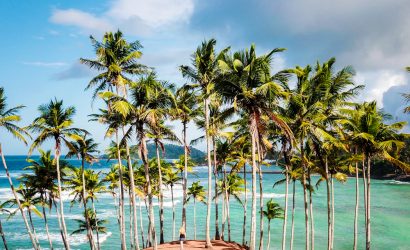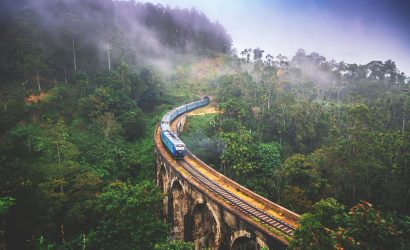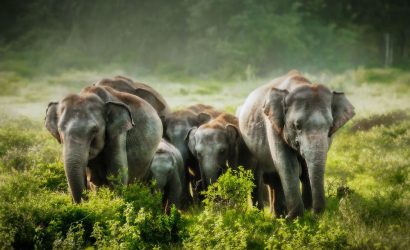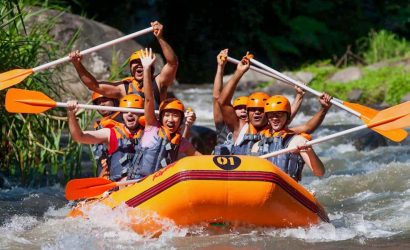Horton Plains National Park
Horton Plains National Park is a national park in the central highlands of Sri Lanka that was designated in 1988. It is located at an elevation of 2,100–2,300 m and encompasses montane grassland and cloud forest. It is rich in biodiversity and many species found here are endemic to the region.
The list of the best places to visit in Sri Lanka is incomplete without the mention of Horton Plains National park. For those who enjoy being in nature and love hiking should definitely make a trip down to the Horton Plains. The terminal point of hike is the world’s end from where you will get to enjoy the ethereal views. You will also find misty waterfalls, enchanting lakes, and a variety of flora-fauna in the park
You will need at least a day in the park. The hike to the world’s end is 4 km long and it takes about 4 hours to complete the whole circuit. Do not miss the Far Inn Hunting Lodge that act as a cafe and a visitor centre. January to March is the best time to enjoy the scenery in the park.
Architecture
Sri Lanka has an impressive architectural legacy that dates back to the 3rd century B.C. Ruins of ancient kingdoms provide evidence of a sophisticated civilization on the island which possessed advanced knowledge of science and technology, town planning and design, and valued the aesthetic beauty of the arts: marvel at the remarkable engineering of 5th century Sigiriya Rock Fortress; admire the spectacular paintings and statues at Dambulla Cave Temple, and see the towering dagobas at Anuradhapura, which were once some of the largest man-made structures in the world, second only to the pyramids of Egypt.
The later influences of the Portuguese, Dutch and British during their periods of colonial rule can be seen most prominently in the architecture of the churches, forts and homes in the coastal areas, especially the UNESCO World Heritage Site Galle Fort, as well as in the hill country’s tea planter bungalows and the railway line that connects the Sri Lanka’s tea country with Kandy and Colombo, the main sea port.
Geoffrey Bawa, Sri Lanka’s most influential modern architect, was responsible for linking the ancient architecture of this island with that of the modern world and is also renowned as the creator of the architectural style ‘tropical modernism’. Discover his spectacular works through our Bawa Gems tour: explore Lunuganga, his country home and gardens; stay at a hotel he designed, such as Heritance Kandalama which he envisioned as ‘an austere jungle palace’, and visit Paradise Road in Colombo, Bawa’s old design studio which now sells a range of arts and crafts and houses The Gallery Café, one of the capital’s best restaurants.
Art and Craft
The story of Sri Lanka’s arts and crafts comes from within one of the oldest civilizations in the world. It dates back to thousands of years and is firmly rooted in authentic culture. Its colours, sounds, rhythm, and shapes run through the course of history. From the art of puppetry to drum-making, the island’s artistic flair never fails to amaze those who encounter it. Sri Lankan art history that emerged with the introduction of Buddhism to Sri Lanka is the most dominant. From cave paintings to rock sculptures, the ancient kingdoms of the nation provide stunning evidence of skillful artistry from bygone eras. Sigiriya frescoes, Dambulla cave paintings and sculptures, and stone carvings of Anuradhapura and Polonnaruwa have earned their reputation worldwide. The Kandyan dancers, the folklore masks, handloom fabric, Beeralu lace making, and lacquer work in Sri Lanka are unique to the island. Sri Lanka also holds one of the most popular literature events – the Galle literary festival.
Birdwatching
Sri Lanka is a birder’s delight. Its tropical climate, relative isolation and astonishing biodiversity is responsible for the amazingly varied birdlife which comprises more than 400 species. Almost 200 migrant species descend on the country each year, having flown south for the winter – some, like the sandpipers and plovers, come from as far north as the arctic tundra. Within a two-week birdwatching holiday in Sri Lanka, you can easily see all 33 endemic birds along with at least 200 species. Whether bird watching is your passion, or you merely fancy a dabble, pick up a pair of binoculars, a guidebook and a notepad and join us in this birdwatcher’s paradise.
Buy Gemstone and Spice garden
Sri Lanka is an island of Indian ocean, located in southern tip of India. It measures 65,610 square kilometers (40,768 square miles), with 1,340 kilometers (832 miles) of coastline. In Sri Lanka, there are lot of natural resources therefore many tourists came here to spend their holiday.
Most of country in the world, Sri Lanka known as by their tea and gems. Throughout the history of Sri Lanka, this country known as “Ratna – Dweepa” this Sinhala name connotes the meaning “The Island of Gemstone”. Local and foreign chronicles and ancient reports attest to this name (Land od gemstone).
Today Sri Lankan gems are most popular goods among the Tourists. Tourists who visit to Sri Lanka they are willing to buy Sri Lankan gems and jewelers. They are preference to Sri Lankan gems.
In Sri Lanka, there are 200 minerals have been classified as gemstone. Their beauty, durability, rarity and combination of these attributes which should be fulfilled make a mineral worthy of being classified as a gemstone.
The main gemstone species found in Sri Lanka are Blue Sapphire, Ruby, Padparadscha, Yellow Sapphire, Asteriated Sapphires (Star Sapphires), Alexandrite, Spinel, Tourmaline, Beryl, Quartz, Moonstone etc.
Sri Lanka is well known for production and hosting of spice garden and hence known as the Land of Spices. There are 15 distinct types of spices are cultivated in the spice garden of Sri Lanka; most of these spices are being exported to the global Spice Market. Spices are one of the major products of Sri Lankan Spice garden. Everyone and specifically the tourists from different places should have to know the right place to visit for the purchase of pleasurable and required goods and so for the spices. Visiting and purchasing the things and commodity-like spices requires a good knowledge of availability. If a guest does not realize the correct spots to buy species, it’s so simple to be tricked for low-value flavors or pay pointlessly over the top costs. Visit Sri Lanka which is known for species, without observing those amazing spices creature developed would really be a pity as well.
Spice Gardens shapes a key fascination with Sri Lanka. The nation is well known over the world for its uncommon accumulation of spices and herbs. The key fascination of this area is to investigate the famous and additionally the unusual herbs being are prepared in the most stunning way. Herbs those are regular in a family unit like Peppercorns, Turmeric, Cardamom, Cloves, Nutmeg, Cinnamon, Vanilla, Aloe Vera, Cocoa, and so on are being handled here. The best piece of visiting the Spice Garden in Kandy is to assemble learning about the herbs, their development procedure, their advantages and helpfulness in Human life. The common habitat and tranquil excellence of the spice Garden is one of the hypnotizing encounters for each traveler. Far from the bundle of town life, this is a total differentiation of condition.
In Sri Lanka, not all spices are grown in the same garden. So, the visitor should have to choose the right place for right spice. They may hire a guide or can use digital advisory to be familiar with the spice gardens and types of spice are cultivated and grown in some particular garden.
Culture and History
The culture of Sri Lanka mixes modern elements with traditional aspects and is known for its regional diversity. Sri Lankan culture has long been influenced by the heritage of Theravada Buddhism passed on from India, and the religion’s legacy is particularly strong in Sri Lanka’s southern and central regions. South Indian cultural influences are especially pronounced in the northernmost reaches of the country. The history of colonial occupation has also left a mark on Sri Lanka’s identity, with Portuguese, Dutch, and British elements having intermingled with various traditional facets of Sri Lankan culture. Additionally, Indonesian culture has also influenced certain aspects of Sri Lankan culture. Culturally, Sri Lanka possesses strong links to both India and Southeast Asia.
Night Life and Shopping
From chic relaxing cocktail lounges, and modern international restaurants – to lively pubs, tapas bars and sports bars boasting snooker tables and large-screen TV’s, there’s something for everyone.With ever-popular karaoke bars, nightclubs showcasing new musical talent, and pulsating discos – the choice is endless.
If you are looking for the ultimate party destination in Sri Lanka, then all your quests will lead you to Hikkaduwa. The Hikkaduwa nightlife is famous for attracting all the party. It has one of the most vibrant party atmospheres. So famous is its nightlife that Hikkaduwa has a dedicated portal displaying all the nightlife party venues throughout the year! With the ocean waves in the background and the sandy beach beneath, the party will never stop in such a relaxing setting! You could milk the Hikkaduwa party scene without denting a hole in your wallet!
Sports and Adventure
Sri Lanka is a fantastic holiday destination for those who like to stay active, whether you want to indulge in some exhilarating water-sports or climb a mountain. The island’s diverse landscape means that there is a wide range of adventure options available: trek through Sinharaja Rainforest; go white water rafting down the rapids at Kitulgala; explore Sri Lanka’s ancient ruins by bike or on foot; climb Adam’s Peak, Sri Lanka’s sacred mountain, or take the train into the island’s stunning hill country.
There are also many different sports on offer in Sri Lanka, most popular being the thrilling water-sports available around the country’s coastline: go surfing in Arugam Bay, one of the top ten surf spots in the world; try kite-surfing and windsurfing on Kalpitiya Lagoon; go scuba diving in the south coast, or snorkel at Pigeon Island near Trincomalee. There are also opportunities for walking – mostly in the cool climate of Sri Lanka’s spectacular hills – and cycling, such as exploring the beautiful inland areas around Galle by bike
Wild Life
Wildlife of Sri Lanka includes its flora and fauna and their natural habitats. Sri Lanka has one of the highest rates of biological endemism (16% of the fauna and 23% of flowering plants are endemic) in the world.





